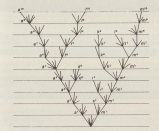Miniprojects
Adaptive dynamics and phylogenetic trees
Supervisor: Markus Kirkilionis (WMI)
Inspired by the ideas of Darwinian evolution we would like to understand better (by modeling and simulation) the connection between units (animal and plant species in Darwinian evolution) being able to mutate and evolve, and the opportunities created by the unit’s environment, often called niches in the ecology literature. These two factors determine the shape of a phylogenetic tree (or better class of trees as all evolution is a random process) created by evolvable units and their branching. The research objective is to find phylogenetic tree structures and their geometric representation given different assumptions on the evolutionary process itself. Here we use different approaches to model evolution, in general a combination of adaptive dynamics, population dynamics, food web construction (‘niche model’). The project will collect the different methods that are needed for such an investigation and discuss their connection.
Agent-based models for practitioners in multi-agent health care pathways (Sponsor NHS Institute for Innovation & Improvement)
Supervisor: Yasmin Merali (WBS)
The NHS is a complex system in which many semi‐autonomous organisations interact in order to deliver healthcare and to prevent ill‐health for the population they serve. Scenario Generator is built on top of the SIMUL8 discrete event simulation product and represents the healthcare delivery system as a series of parallel pathways of care that together describe a whole health community. It has proven useful for planning provision of care where the main focus is on changes to the processes or pathways of care provision. However, managers find it harder to use the model when the main focus is on other aspects of care planning, such as improving health or service quality outcomes, reconfiguring whole healthcare services (such as decommissioning of small hospitals), or optimal means to achieve efficiency savings. Furthermore, DES models such as this do not readily allow for modelling impact of non‐process based influences such as human behaviour or public preferences. Could an agent‐based modelling approach offer advantages for such strategic planning needs over SD or DES?


